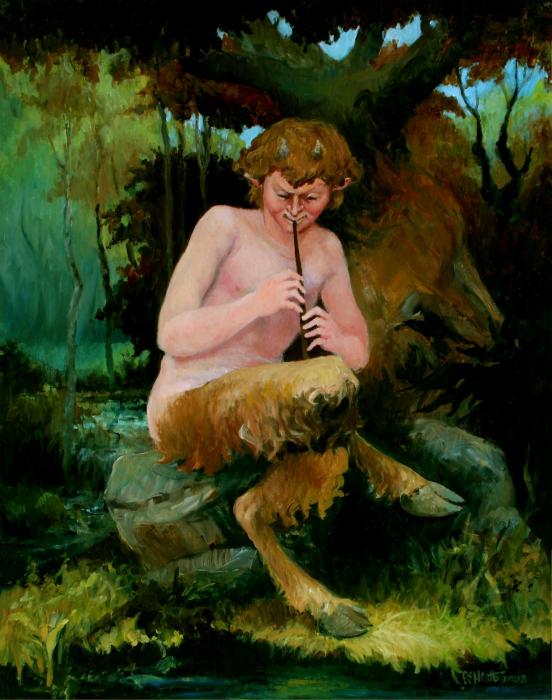There are several features that make a Satyr obvious. Firstly, they are only half human. Their waist downwards is that of a goat. Their torso and head is of a human, but on their head they have very curly hair, with two small goat horns emerging from their skull. All Satyrs are male. Their backs are usually very hairy, and always go around in the nude. Their goat legs are enough to cover any genitalia. Their hooves are much like a domestic goat's. They are not as hard as a horse's, but perfect for climbing boulders. They will never wear shoes like a horse or human. Satyrs never shave, and do not cut their hair. Their hair does not grow down, rather it curls around their skull like a thicket.
As all Satyrs are male you may think they will end up extinct. This is not possible, as they do breed. They mate with the Dryads and Nymphs, who are all female. They are the water and forest spirits, and near impossible to catch sight of. Any female offspring will always be a Dryad or Nymph, and the male offspring will always be a Satyr.
The Satyr goes through a similar process in puberty as humans. When they are young they have no beard and less pubic hair, but as they approach their teenage years it begins to change. Satyrs may live for a considerable time, and puberty can vary with each Satyr. The process usually begins about an eighth of the way through their lives. They begin to grow a beard, and pubic hair emerges. Their hairless backs become forests of fur. Horns begin to make their way out of the Satyr's skull, and grows every year. A Satyr begins life with no horns, but when they die they may have long curled ones. the horns never stop growing, which is why the bigger the horns the older and (sometimes) wiser they are.
The Satyrs follow the gods Dionysus and Pan, or as the Romans put it, Bacchus and Pan. Dionysus is the Greek god of wine, and the Satyrs are often seen surrounding him, as they are mischievous and in character much like him. Pan is the god of nature and forests, so it seems only natural the Satyrs would flock around him. The Satyrs also follow Silenus, and his donkey. Silen is an ever-drunken figure, who Dionysus and the Satyrs are often associated with.
The Satyrs are also very famous and well-known for another reason. The flute. It is rare to spot a Satyr, but if you do it will probably be playing the flute. They are famed for their night-time dances. Whether it is summer or winter, the Satyrs will be in a forest playing flutes and dancing to the music, more often than not with one of the gods and a few Nymphs.
For more information visit:
- http://www.theoi.com/Georgikos/Satyroi.html
- http://www.mythicalcreaturesguide.com/page/Satyr
- http://www.mythicalcreaturesguide.com/page/Faun
- http://mythology.wikia.com/wiki/Faun
- http://en.wikipedia.org/wiki/Satyr
- http://en.wikipedia.org/wiki/Faun

No comments:
Post a Comment